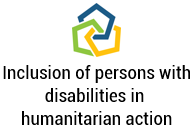Persons with disabilities remain one of the most at-risk, marginalized and invisible groups in crisis. More than one billion people worldwide, approximately 15 percent of the global population, have disabilities. Approximately 80 per cent of people with disabilities live in the Global South, and persons with disabilities have a higher likelihood of living in poverty. The prevalence of disability increases as people become older.
An estimated 54 million people with disabilities are affected by humanitarian crisis, and at least 16.3 million were thought at the end of 2022 to be forcibly displaced due to persecution and other human rights violations, conflict and violence. When fighting breaks out or when disaster strikes, persons with disabilities are often unable to flee and left behind. The number of persons with disabilities tends to go up in emergencies, as people are injured by fighting, falling debris, or explosive devises, and their access to medical care and essential services is hampered. Research has found that the death rate of persons with disabilities in a disaster can be up to four times higher than for those without disabilities. And when they reach relative safety, people with disabilities often fall through the cracks of response efforts or face barriers to access even the most basic life-saving assistance and protection. Seldom are persons with disabilities meaningfully consulted nor actively involved in the decision-making processes which affect their lives.
A Charter on Inclusion of Persons with Disabilities in Humanitarian Action, developed in cooperation with over 70 stakeholders, was launched during the World Humanitarian Summit in May 2016. More than 255 States, UN agencies, international organizations, NGOs and global, regional and national organizations of persons with disabilities have endorsed it in the meantime. They all committed to render humanitarian action inclusive of persons with disabilities, by lifting barriers persons with disabilities are facing in accessing relief, protection and recovery support and ensuring their participation in the development, planning and implementation of humanitarian programmes. The Charter continues to be open for endorsement by interested Governments, UN agencies, organizations involved in humanitarian contexts and organizations of persons with disabilities.
Many initiatives and projects are taking place to foster the inclusion of persons with disabilities in humanitarian action, many of which are guided by the IASC Guidelines, drafted in cooperation with organizations of persons with disabilities. However, more progress remains required. The HNPW provides a useful platform to give visibility to this important issue.
|

